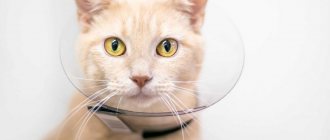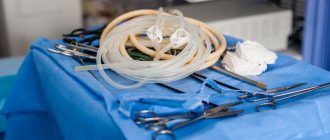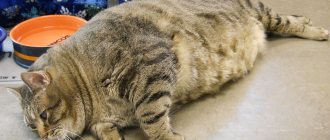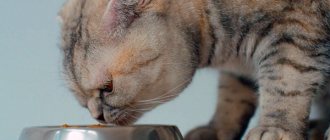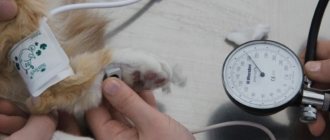Home » Cats and sterilization » Chemical castration of cats
Responsible cat owners who monitor their health always castrate and sterilize their charges. This is good both for the health of cats and for the comfort of the owners themselves. Unless, of course, you are a breeder of pedigree cats and are not breeding kittens for sale. Veterinarians carry out sterilization of cats in a standard way - surgically or with the help of medications, this is called “chemical castration of cats”.
The “surgical castration” itself, which is carried out by most clinics, is technically a very simple operation that will require the doctor to spend several tens of minutes from the beginning to the end of the operation; it does not in itself cause complications. After such an operation, cats return to their “normal state” very quickly, which is why most owners prefer to perform this operation on their cats.
Why is chemical castration done on cats?
The standard procedure (surgical) is unfortunately not suitable for all cats. There are animals for which, for example, due to health reasons, general anesthesia is contraindicated, or surgical castration is not suitable for them for another reason, for example, due to age.
In such cases, to relieve “hormonal tension” and “stop cat spree” there is exactly this method: chemical castration of cats .
Although chemical castration is little known to cat lovers in Rostov-on-Don, in the central and northwestern regions of our country and European countries, veterinary clinics and private offices often carry out this procedure, and cat owners know about it and actively use it. In this article we will look at the main aspects of the chemical castration procedure for cats as an alternative to surgery in more detail. Read our article further to find out more.
What does chemical castration of cats mean?
Chemical castration refers to the injection of a special veterinary drug into an animal. Unlike surgery, this is suitable even for older cats because there is no need for general anesthesia. The drug administered during the procedure is specially developed and produced only in Europe.
Chemical castration has been recognized by the Veterinary Association as a working method in 100% of cats spayed this way. The best age for it is seven months and older.
It is better when the cat begins to exhibit sexual behavior before the procedure, this is important to support hormonal functions and complete the processes of growth and development, just like surgically, chemical castration should also not be carried out too early, you need to let the cat grow up. Like “surgical” castration, chemical castration should be performed on mature cats. The age of 7 months is optimal for this. Do not forget that this procedure is an alternative to surgery; if your cat has no contraindications, it is better to undergo surgery.
Pros and cons of sterilization without surgery
Like any other intervention in the normal functioning of the body, chemical sterilization has a number of advantages and disadvantages.
Advantages
Advantages of non-surgical intervention:
- There is no recovery period after surgery, the procedure does not in any way affect the pet’s usual lifestyle;
- the procedure does not require the use of anesthesia, which is difficult to tolerate even in healthy cats;
- the administered drug begins to act immediately, there is no need to wait for the result;
- reversibility - a chemically sterilized cat is able to have offspring after discontinuation of the drug;
- no risk of infection during surgery.
Flaws
Along with obvious advantages, the chemical method of sterilization has serious disadvantages:
- taking medications is necessary throughout the cat’s life;
- chemical sterilization involves the constant purchase of new doses, which is much more expensive than a one-time surgical intervention;
- substances included in sterilization products have side effects such as increased appetite and obesity, hair loss, lethargy;
- the hormones included in the drugs interfere with the cat’s own hormonal system and can harm its health in the form of various tumors, ovarian cysts, endometritis, pyometra (uterine infection).
Chemical sterilization of cats is carried out in different ways: injections, taking pills, radiation exposure, implantation of the drug under the skin.
Pills
Tablets or drops – these drugs suppress estrus and completely eliminate the possibility of conception.
In fact, such tablets are hormonal contraceptives for cats, which must be taken regularly throughout their reproductive life.
This medical sterilization is the most inexpensive, but has serious side effects in the form of tumors of the mammary glands and ovaries.
Injections
Solutions are administered intramuscularly by injection. The main substance is a steroid hormone, which changes the properties of the uterine secretion and complicates the movement of the egg, eliminating the possibility of its implantation in the uterine cavity.
The drug also suppresses the production of one’s own sex hormones, reduces their concentration in the blood, and inhibits the desire to reproduce. Injections must be given strictly between heats, otherwise the consequences will be irreversible.
Hormonal medications are taken by injection according to a special regimen throughout life. It is forbidden to give injections to a cat during estrus, pregnancy and breastfeeding.
Also, the method of hormonal sterilization should be abandoned if the pet has diseases of the genitourinary system or diabetes.
Hormonal medications can only be used for young cats after their first heat. For pets over 5 years old who have not previously taken such medications, hormonal injections are prohibited.
Radiation exposure
This method involves irradiating the genitals with radioactive isotopes, after which the reproductive function is suppressed and stops working.
The radiation method of sterilization is a rare phenomenon, since radiation is used primarily to treat tumor diseases of the uterus and mammary glands.
At the same time, there is a high risk of irradiation of other organs and tissues, which will lead to health problems.
Compared to hormonal drugs, radiation exposure is considered a more gentle method of sterilization that does not have serious side effects.
Implant sterilization
The most modern method, widely used in European countries. The method involves introducing a special implant containing the drug under the skin of an animal.
The substance from the implant enters the pet’s blood gradually in small doses. This allows you to gently suppress the animal’s sexual desire without sudden hormonal surges.
A special chip is installed in cats for 1 or 2 years.
After removal of the implant, sexual function is completely restored and the cat is ready to conceive.
The implant method is characterized by the absence of incisions on the animal’s body, a mild effect on the reproductive system and high safety for the pet’s health. Unfortunately, this method of sterilization has not yet become widespread in Russia.
Is the effect long lasting?
Depending on the drug, the cat's heat suppression is permanent and reversible, and is suitable as a temporary or measure for people who may wish to allow their cat to reproduce in the future.
The drug can dampen hypersexual behavior in cats, including those associated with aggression, and which is present in non-neutered cats. In most cases, the effect of the drug lasts about a year or two, after which a repeat injection is required to maintain the effect.
Indian experiment
Clinically healthy 30 cats from all over the country, weighing 2-3 kg, aged from nine months to a year, with normal libido during the breeding season (spring), were acclimatized for a month. Each cat was additionally tested by preliminary mating with a cat during the period of estrus. After this, an experiment was carried out.
The minimum effective dose of calcium chloride was estimated by randomly dividing these 30 animals into 5 groups. Each animal in the first three groups (Groups I, II and III) received a single bilateral injection of 0.25 ml of 5%, 10% or 20% sterile calcium chloride dissolved in saline.
General anesthesia (i.e., general anesthesia) was not used.
It was soon found that the ideal dose was 0.25 ml of calcium chloride at a 10% concentration. The fourth group was the control group - the animals were injected with 0.25 ml of physiological solution with 1% lignocaine hydrochloride. The fifth group underwent conventional surgical castration.
The essence of the technique
Each injection was performed using sterile 1 ml syringes. The needle was directed from the apex of the testicle to its process (epidydymis). The calcium chloride solution was injected evenly throughout the entire movement of the injection needle.
It is important to note that the composition was injected strictly into the parenchymal tissue of the testes, preventing it from entering the surrounding tissues.
The fact is that when it gets into the subcutaneous tissue and muscle tissue it causes severe necrosis, accompanied by the formation of abscesses.
None of the animals in the experimental groups suffered from fever or any significant difficulties other than a slight increase in testicular hardness upon palpation.
Experiment results
Most animals showed signs of mild discomfort about five minutes after the calcium chloride injection, but cats in the control group, which were treated with normal saline, had exactly the same reaction.
This is probably just a side effect characteristic of “foreign” fluids getting inside the testes. Mild swelling was noticed one day after the procedure. Indian veterinarians report that on average it disappeared after 72 hours, but in one case this period extended to four weeks.
After 60 days, all cats were completely healthy, no side effects were detected in any case.
A single injection of calcium chloride resulted in a significant decrease in somatic index compared to animals injected with saline alone. It also turned out that the 10% drug gives results similar to the 20% composition. The least effective was the 5% solution. The testes of animals subjected to its administration decreased in volume
(approximately three times). It was found that when using 20% calcium chloride, the most significant reduction in testicular size occurs.
Benefits of chemical castration.
Chemical castration of cats is an excellent option for animals that cannot undergo spaying under general anesthesia, the procedure is quick, unobtrusive, and simply requires an injection, there is no chance of post-operative infections or complications, and there is no wound site.
- No risk of anesthesia
- No chance of postoperative complications
- There is no recovery period after
- No preparation needed
- Takes little time
- Costs less than surgery
One thing that often stops cat owners from spaying is that they don't want the cat's natural appearance to change, they are afraid of obesity or complications from the anesthesia. There are no such problems with chemical castration.
Postoperative period
Usually the animal quickly recovers from anesthesia, and the postoperative period passes without complications. During the first 24 hours, you should look after your pet and limit its mobility. The first hours after waking up the cat will stagger. After 3-4 hours you can give him water. Do not allow the operation site to be licked; monitor the hygiene of the tray. It is better not to use the filler for a few days.
After the operation, the wound will cause discomfort to your pet for several days. It may itch, then the cat will try to lick it. It is recommended to treat the wound with an antiseptic and put a protective collar on the cat.
You can feed the cat only the next day after surgery. The diet will have to be reconsidered - castrated cats are at risk of developing urolithiasis and kidney problems.
Some owners ask the veterinarian why the cat loses weight after castration . Short-term weight loss is the norm; after suffering stress, the body needs some time to recover. With the right food and proper nutrition management, appetite will return and metabolism will normalize.
If after a few weeks the weight has not returned to normal, you should contact a veterinarian. Reasons for losing weight may be:
- the presence of worms;
- disruption of internal organs.



